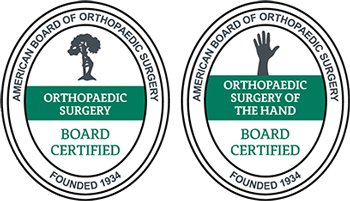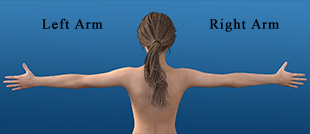Complex Regional Pain Syndrome (CRPS)
Contents
- 1 What is Complex Regional Pain Syndrome?
- 2 What causes Complex Regional Pain Syndrome?
- 3 What are the symptoms of Complex Regional Pain Syndrome?
- 4 How is Complex Regional Pain Syndrome Diagnosed?
- 5 How is Complex Regional Pain Syndrome Treated?
- 6 How can Dr. Knight help you with CRPS?
- 7 Complex Regional Pain Syndrome (CRPS) Fact Sheet
- 8 Frequently Asked Questions:
- 9 Animated Videos
What is Complex Regional Pain Syndrome?
Complex Regional Pain Syndrome (CRPS) is a constellation of symptoms, the hallmark of which is pain out of proportion to an injury, involving an extremity of the body. It commonly involves the hand, arm, foot, or lower leg. The cause of CRPS is unknown, and all aspects of the disease, from diagnosis to treatment are constantly being re-defined as physicians and researchers attempt to better understand the illness.
What causes Complex Regional Pain Syndrome?
There are currently two recognized types of CRPS. Both types involve injury to the affected limb. Type I is caused by indirect, presumed, trauma to the nerves of an extremity. Type II is caused by a well-defined, direct injury to a specific nerve (or nerves) in the extremity. Type I accounts for the clear majority of cases of CRPS.
In Type I CRPS, nerve damage does not occur directly, but the healing and inflammatory response to injury is thought to affect nerve function. One cause of type I CRPS is immobilization. Immobilization may occur iatrogenically by the placement of a plaster cast following a fracture or may occur in the patient who protectively guards the limb following a minor injury. For this reason, frozen shoulder syndrome and biceps tendinitis are linked to CRPS of the hand. Crush injuries to an extremity, or soft tissue injuries, like a sprain or strain, have been shown to cause type I CRPS.
Type II CRPS results from direct injury to a specific nerve. An example would be a severed nerve due to an amputation or nerve damage sustained from a fracture.

What are the symptoms of Complex Regional Pain Syndrome?
Pain which is out of proportion to the injury sustained is the hallmark of CRPS. The pain is described as burning, stinging, tingling, or throbbing and is worse when the affected limb is moved. The pain is not limited to the distribution of a single nerve or group of nerves as would be expected with a nerve injury, but instead involves a region of the extremity which cannot be explained by nervous system innervation. Mobility may be decreased due to pain with movement, and the patient may claim extreme mental focus is needed to make the limb to move. Movement of the limb causes marked fatigue. Swelling, increased sweating, and temperature changes of the skin are also common, with both warmth and chill experienced. Some experience discoloration of the skin and changes in the hair and nails of the affected extremity.
Symptoms may begin immediately to weeks after the traumatic event. Most cases of Type I CRPS will resolve within 18 months, those which last longer have a poorer prognosis.
How is Complex Regional Pain Syndrome Diagnosed?
CRPS is a diagnosis of exclusion. All other explanations for the symptoms must be excluded. A complete workup should be performed to exclude nervous system disease, vascular disorders, psychological disorders, metabolic disorders, autoimmune disorders, infectious disease, and exposure to toxins.
A full panel of blood tests will help rule out many other possible diagnoses. Electromyography and Nerve Conduction studies, along with vascular studies of the affected limb will be helpful. X rays, bone scans, and MRI are employed to look at the bony and soft tissue changes that may occur in CRPS. While not diagnostic of the condition, these findings will help guide treatment options.
Quantitative Sensory Testing can objectively document hot and cold sensation and pain response. Autonomic Function Testing can measure skin temperature changes and the sweating response seen in CRPS.
How is Complex Regional Pain Syndrome Treated?
Non-surgical
The pain and dysfunction of CRPS can be lessened with pain medications. Over the counter pain medications or prescription pain relievers may be used depending on severity. Sometimes, opioid narcotics may be needed to adequately control pain. Oral corticosteroids, given for a short period of time, improve symptoms. Some antidepressant medications and anti-epileptic medications have proven useful in pain caused by damaged nerves and work well in CRPS.
Anesthetics can be administered intravenously or transcutaneously in a nerve block to alleviate pain.
Physical therapy is useful to restore or maintain range of motion of the affected limb.
In refractory cases of pain, a transcutaneous electrical nerve stimulation (TENS) device may be placed, which is thought to block the ability of the nerve to sense pain. A series of stellate ganglion nerve blocks in the neck is usually beneficial.
Surgical
Options for surgical relief include placement of a spinal cord stimulator or surgical sympathectomy.
How can Dr. Knight help you with CRPS?
CRPS is one of the most debilitating pain conditions in the world, and Dr. Knight recognizes this fact and will work hard to make sure that you are relieved of your pain. Dr. Knight and his pain management colleagues will aggressively treat this condition to the best of their ability until a reasonable progress is made, and the pain is controlled as much as medically possible and through aggressive therapy, function returned.
Our offices are easily accessible from Dallas and Dr. Knight is considered one of the top hand doctors in Dallas, TX. Come to our Dallas office or Southlake office to see what he can do for you.
Complex Regional Pain Syndrome (CRPS) Fact Sheet
| Complex Regional Pain Syndrome sounds serious; what is it, exactly? | CRPS can be caused by several traumatic injuries to the nerves in the upper extremities, either as the result of injury or inflammatoryresponse to healing, which means that its etiology is complex. |
| Is CRPS something I absolutely have to see a doctor for? | CRPS can be a very painful condition and so treatment at home without medical intervention is not recommended. |
| What kinds of medicine can I expect to be taking to treat my CRPS? | Due to the intnese pain associated with CRPS, painkillers of various strengths are generally required. The condition has various levels of severity, and only your doctor can determine the appropriate dosage to deal with your specific level of pain. |
| Is CRPS permanent? Can it be cured? | CRPS, if detected early enough, can be stemmed, but once the symptoms have developed it is not going to be cured, and is a matter of dealing with the symptoms. |
| IS CRPS a mental illness? | CRPS isn't iself a mental illness, but the pain that it causes can lead to the development of depression and other mood disorders, as well as lead to possible abuse of painkillers and the associated ramifications of that. |
| What options do I have for treating CRPS? | Physical therapy and medication are the only reliable treatments for CRPS, and as the condition progresses conditions like depression may develop and they may also require treatment. |
Frequently Asked Questions:
Is CRPS a mental illness?
There have been some studies and some doctors who believe that there is a mental component to CRPS, due to the severity of the pain associated with the condition. The effects of CRPS, however, can manifest in various ways that are closely related to mental illness. Anxiety, depression, anger management problems and other ostensibly mental afflictions can result from the constant and unremitting pain typified by this condition, so the answer is no, but it may be responsible for symptoms that resemble mental illness.
Can CRPS go away?
Unfortunately, the quick and easy answer to this question is no. In very rare cases when the first signs of CRPS are detected and treated, it may be early enough to, for all intents and purposes, “cure” the condition, but by the time most people seek treatment because of increasing pain, the condition is too far advanced to do much but control the worsening of symptoms already present. In severe cases, where the patient doesn’t’ seek treatment for many years and just manages the pain on their own until it becomes unbearable, the symptoms of CRPS may not respond to treatment at all, which is the worst possible scenario.
Is CRPS an autoimmune disease?
Because the precise mechanisms underlying CRPS are unknown, there have been a mountain o studies and investigations into what causes the debilitating condition, and there is still no medical consensus as to what the most likely causes might be. Some studies have possibly indicated that there is an autoimmune component to the development of CRPS, but these results are sketchy and not well-understood or corroborated. At this time, there is no reason to believe that CRPS can be classified as an autoimmune disease.
Is CRPS hereditary?
As discussed above, the precise mechanisms that underly CRPS are very little understood by current medical science, and so a definitive answer cannot be given as to the relationship between CRPS and genetics. Some studies have indicated that CRPA may occur within families, but whether this is a genetic or environmental or simply a random occurrence is unclear, so to be honest, we don’t really know.
How common is CRPS?
CRPS is a comparatively rare disorder, with only about 20,000 occurrences in the US every year. IT occurs approximately three times as often in women as in men and isn’t usually diagnosed until after the age of 40, but there are always atypical cases.
Animated Videos
Disclaimer
HandAndWristInstitute.com does not offer medical advice. The information presented here is offered for informational purposes only. Read Disclaimer

























